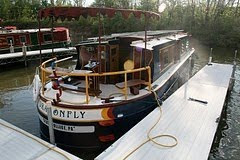 |
| Dad also saves energy by biking around town |
We celebrated Mother's Day with a visit from the crew's parent's, Jay and Kitty Berger. It was a fitting bookend to this trip. Exactly one year ago on Mother's Day weekend, Jay and Kitty climbed aboard the Dragonfly for her shake-down cruise on the Erie Canal.
This past year, while we've been touring under solar power, Dad has been working on energy conservation, too. In the small Massachusetts town where they live, he's a politically active guy, and a couple years ago he launched "Go Green Agawam," encouraging residents AND town government to adopt energy conservation strategies.
The goal was to reduce energy use by a full 20 percent. In Massachusetts, towns that have an effective plan to meet this goal can receive "Green" designation from the state, becoming eligible for grants to move their plans forward.
Agawam later created an Energy Commission to keep the ball rolling--and Dad was appointed a commissioner. Now we call him "The Commish."
This kind of small-town initiative is more common than you might think. Here in the Hudson Valley, a group called "Sustainable Hudson Valley" has put forward the "10 Percent Challenge," inviting communities and individuals to cut energy consumption 10 percent.
 |
| Catskill Creek is fine for rowing! Just think, if America implements its National Canal Initiative, you could row to work. |
Meanwhile the New York Department of Environmental Protection has a coordinating program, "Climate Smart Communities." So far, 92 communities are enrolled.
Plans like these do more than protect the environment. They also save money. The Village of Montebello, NY--which by the way has solar panels on its town hall--upgraded the lighting and insulation in town buildings and cut municipal energy costs by a third. Low and no-cost conservation measures in Buffalo (simple steps, like turning off computers at the end of the workday, duh!) saved the city 71K a year.
And check out the innovative programs of the Cambridge (MA) Energy Alliance, which put together an innovative financing plan for energy-efficient retrofits to city buildings at no cost to taxpayers.
If you're curious about what you can do, a fun first step is to collect your recent power and fuel bills and check out this Carbon Footprint Calculator. To think intelligently about change, you need to know what you're changing!





No comments:
Post a Comment